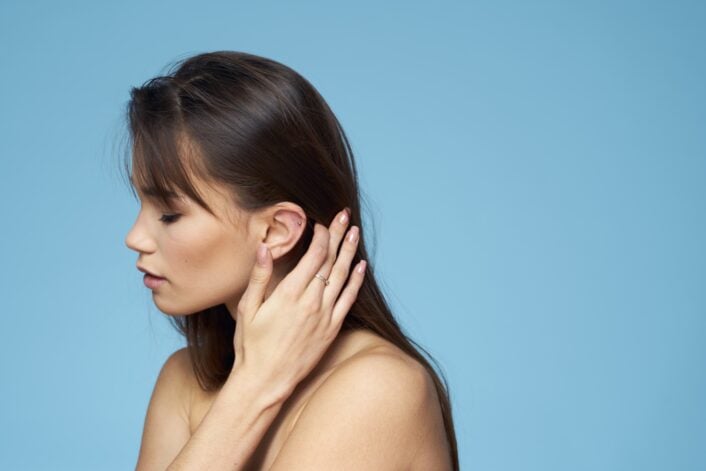

Disclaimer: This article is for informational purposes only and is not intended to diagnose any conditions. LifeDNA does not provide diagnostic services for any conditions mentioned in this or any other article.
While earlobes might seem similar to everyone at first glance, they vary in shape due to genetic differences. The earlobes or the bottom tip of your outer ear doesn’t contain cartilage which makes it firm, yet flexible connective tissue that supports body structures. Instead, it is made up of fleshy tissue called areolar connective tissue that makes up the earlobe making them soft and flexible. This type of tissue is made of nerves and blood vessels, which is why they can be easily pierced and heal quickly.
The functional role of earlobes in hearing remains unclear, but they are believed to be mainly composed of extra tissue that helps form the structure of the ear. They contain blood vessels, which might help regulate ear temperature and keep them warm. This biological aspect, combined with its distinct shapes, highlights how earlobe types are deeply rooted in genetics. Understanding how these traits are inherited offers fascinating insights into our genetic makeup and the complex relationship of inherited traits.
You May Also Like: Can Age-related Hearing Loss Be Genetic?
The human earlobes may appear to be attached, partially attached, or free from the sides behind the face. Research indicates an average size of 1.88 cm in height and 1.96 cm in width, with the potential for ongoing growth throughout life, linked to factors such as aging, stretching, and sagging. Contributing to elongated earlobes over time are increased facial fat, collagen depletion, and mechanical stress from activities like wearing heavy earrings that affect tissue elasticity and strength.
Characterized by their larger size and the way they hang down from the point of attachment to the head and are not directly connected along their length, free earlobes result from the influence of a dominant allele and are the most common type of earlobes found.
When one or both parents carry this dominant allele, their children are likely to inherit free earlobes. However, it is important to note that even if both parents have free earlobes, their children still can have attached earlobes if both parents carry a recessive allele. This explains the genetic combination that occurs among dominant and recessive alleles, which demonstrates the complex interplay of genetics.
They are smaller in size and connect directly to the side of the head without hanging freely. This type of earlobe is the result of the recessive allele being expressed in the absence of the dominant allele. Therefore, for a person to have attached earlobes, they must inherit the recessive allele from both parents. Interestingly, parents with attached earlobes do not always produce children with attached earlobes; the genetic outcome depends on the combination of alleles present in the parents.
Earlobes exhibit a wide range of sizes, shapes, and thicknesses with encompassing forms like arched, tongue-shaped, square, and triangular. The shape and size of earlobes are primarily influenced by genetics, with specific alleles determining whether earlobes are free or attached. However, other factors such as sex, age, and ethnic background also contribute to earlobe variations.
A study by Pradhuman Verma categorized ear shapes and earlobe attachment types among 80 randomly selected students in India, revealing that 35% had free earlobes, while 65% had attached earlobes. Oval was found to be the most common ear shape in both populations studied. The authors emphasized that ear characteristics, being hereditary and unique to each individual, may serve as reliable markers for personal identification.
This study adds to existing knowledge by focusing on how genetic and ethnic factors shape ear characteristics. For instance, a separate analysis of earlobe length in a study that included 547 subjects found significant variations based on sex, age, and ethnic origin. Women generally exhibited symmetrical earlobes measuring around 1.97 cm on the left and 2.01 cm on the right, while men showed less symmetry, particularly in non-pierced earlobes.
Ethnicity also played a role, with specific populations like Ashkenazi and Sephardic Jews having longer left earlobes compared to Ethiopian, Asian, American Jews, and Arabs. There are also differences based on skin tone where Black individuals generally have shorter earlobes than people with darker or fairer skin tones. These findings show how both genetics and environmental factors affect earlobe characteristics, giving us a better understanding of human diversity in physical traits.
In rare cases, genetic disorders may lead to distinct abnormalities in earlobe shape, providing insights into the complex genetic factors influencing physical characteristics. Here are some:
While earlobe types are generally benign genetic traits, certain shapes may be associated with specific genetic conditions. For instance, attached earlobes have been observed in some genetic disorders. However, for most people, earlobe shape has no significant health impact and remains a unique aspect of their genetic identity.
Earlobes, while often seen as a facial feature, may be at risk for a range of conditions and issues:
Allergic Contact Dermatitis: Earlobes may develop inflamed and itchy skin rashes when exposed to allergens, commonly triggered by nickel-containing earrings. Nickel allergies affect over 18% of individuals in North America.
Infected Ear Piercing: Improperly cleaned or cared for earlobe piercings may become infected, presenting symptoms such as redness, swelling, heat, and pus drainage.
Split Earlobe: Earlobes may tear into two pieces due to injury or from prolonged use of heavy earrings or large-gauge piercings. Partial splits may also develop over time.
Sebaceous Cysts: These can be painful and are commonly linked to overactive oil glands and excessive production of skin cells. It’s formed by the buildup of dead skin cells and oils on the front or back of the earlobe.
Cellulitis: Injuries or cuts to the earlobe increase the likelihood of developing this type of bacterial infection that impacts the deeper skin layers, resulting in redness, swelling, and discomfort in the earlobe
Infections in the earlobe resulting from piercings, insect bites, or other injuries are typically treated with antibiotics as advised by your primary care provider. In more severe cases, such as an abscess forming around an infected piercing, they may refer you to a specialist such as a dermatologist or ENT (ear, nose, and throat) doctor for further assessment and treatment of infections, cysts, or injuries. These conditions highlight the importance of proper care and attention to earlobe health, especially for individuals with pierced ears or those prone to skin allergies and infections.
For individuals seeking to alter the structure and appearance of their earlobes, surgical options are available. Procedures can range from simple lobe reductions to more complex reconstructions, depending on the desired outcome. It’s crucial to thoroughly understand the risks and benefits associated with these interventions.
Ear Reshaping: Ear reshaping, or otoplasty, is a type of cosmetic surgery that modifies the size, shape, or position of the ears to improve facial symmetry and proportion. Typically performed through incisions behind the ear, this procedure sculpts the ear cartilage to achieve the desired aesthetic. It’s a safe procedure overall, although there are potential risks like infection or blood clots. Still, these are rare. During recovery, patients wear a head dressing initially and gradually resume normal activities under their surgeon’s guidance to ensure proper healing and optimal results.
Ear Reconstruction Surgery: Focuses on repairing or rebuilding the outer part of the ear or auricle/pinna. This surgery is often necessary for congenital defects present at birth (microtia repair)
or to restore ears damaged by trauma such as burns or cancer surgeries (ear defect repair). Surgeons use various methods including rib cartilage grafts or medical implants to redesign or create a new ear structure. In some cases, a prosthetic outer ear anchored in bone may be considered as an alternative.


